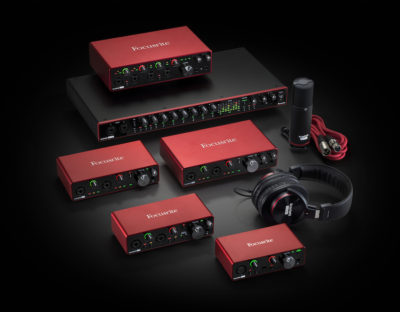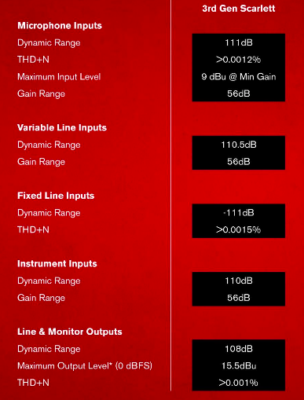New Gear Review: 3rd Generation Scarlett Range from Focusrite

Focusrite unleashes the 3rd Gen Scarlett range, boasting a wealth of key upgrades—can one of these interfaces find a place in your setup?
Focusrite, makers of a wide span of professional audio products, have just released the 3rd generation of their storied Scarlett range of audio interfaces.
I have a long history of working with Focusrite products, and my go-to microphone preamps for many years bear the Focusrite name.
Unbeknownst to many, Rupert Neve, once upon a time, founded Focusrite. For reasons not worth getting into for the purpose of this review, the company has been under new management for very many years since. However, Rupert’s designs remain with the company. This is very compelling because classic Neve mic pres are really where it’s at for me when it comes to audio components. The sweet transformers used in their designs give me just the right tone, enabling me to get great sounds quickly, and add just enough harmonics and coloration to fill out whatever source flows through them.
But old Neve modules are temperamental as they need to be racked with a retrofitted power supply, and their sound can vary greatly from module to module. They are also very pricey per-channel. What Focusrite has offered with their prestigious Red 1 and ISA series of mic pres is a modern take on classic transformer-based Rupert Neve designs. These are not only affordable but rock solid. I personally own a Red 1, an ISA-One, and previously, owned an ISA-828.
In addition to my Focusrite preamps, I also own a 1st Gen Scarlett 18i20 interface, which has been the centerpiece of my mobile studio for many years. It’s a real workhorse with plenty of I/O options, musical sounding A/D and D/A conversion, and 8 mic pres. However, to my ears, the mic pre section of this box was always lacking compared to higher-end options, so I’d pair it with my ISA-One or Red 1 mic pres and use it simply for conversion and monitoring.
Now, with the release of the 3rd Gen Scarlett interfaces, Focusrite has introduced their “Air”-enabled mic pres to the Scarlett range for the first time. These units now can be billed as featuring ISA transformer-based mic pre emulation, which Focusrite claims will give a brighter sound with more depth. This got me very excited to check out these new boxes since I was already routinely pairing my ISA-One to the Scarlett range. Could this new 3rd Gen Scarlett range save me from carrying around a fairly large mic pre when working mobile recording sessions? We’ll see…
Features
The Scarlett range comes in many shapes and sizes. These include the Solo ($109.99), 2i2 ($159.99), Solo Studio ($219.99), 2i2 Studio ($269.99), 4i4 ($229.99), 8i6 ($299.99), 18i8 $399.99) and 18i20 ($499.99). The first number in the model refers to the number of inputs, and the second number to the outputs (both analog or digital). The “Studio” designation on these items means they come with a pair of Focusrite HP60 MkIII headphones and a Focusrite CM25 MkIII condenser microphone—essentially providing an all-in-one-box entry level starter pack.
The software included with Scarlett 3rd Gen interfaces is Ableton Live 10 Lite, Pro Tools First | Focusrite Creative Pack, Focusrite Red 2 & 3 Plug-In Suite, Softube Time & Tone Bundle, XLN Audio Addictive Keys, a 3-month subscription to Splice, and a membership to the Focusrite Plug-In Collective. This is a very nice starter pack for beginners, but pros may opt for more full-featured software.
Also included is the Focusrite Control software, which is where you configure the I/O functionality of your interface; this software is basic, straight-forward, and easy to use. These interfaces operate at sample rates and bit depths up to 192kHz/24-bit, and Focusrite has updated the USB drivers for lower latency and increased stability here. The cosmetics and layouts of these interfaces are very attractive and have been updated from previous generations. The boxes themselves are colored “Focusrite” red and made of metal, which makes them sturdy and road-worthy.
In Use
For my review I was able to get my hands on a 2i2 and a 18i8, taking them on a trip for a live concert event. When I was working at rehearsals I had two rigs set up: one with a UAD Apollo x6, and the second with the Focusrite 18i8; we would switch back and forth between the two. Through the PA I heard no major tonal difference in the D/A conversion of the Focusrite vs. the UAD. I’ve used 2nd Gen Focusrite interfaces in live applications before, and one major issue for me was that they had unbalanced line outputs. Focusrite smartly changed this on their 3rd Gen boxes, which adds a bit more professionalism to this range.
I did find the Focusrite to be marginally noisier than the much more expensive UAD, however in practice this made no real difference. In this case, we’re talking about a very low noise floor already, and the only time I noticed any noise coming from the unit was when the PA was cranked well above what typical gain would be for any playback channel. So, in reality these boxes are very quiet.
I used the 2i2 for mobile editing in my hotel room, and also for recording on location. Both the 2i2 and 18i8 had no problem powering my Avantone Mixphones to very high SPLs when needed. I also used a headphone splitter on the 2i2, and it had no issue powering two sets of headphones at once (it’s worth noting the 18i8 has two independent headphone outs).
I was excited to see what these Air enhanced mic pres were all about when it came time to record a VO for the show. I grabbed my MacBook Air and the 2i2, paired it with a Neumann TLM-103, and found a suitable small office-type space to record the VO. I used the included USB-C to USB-A cable as my MacBook Air is an older variant with USB-2 ports.
When I first connected the mic to the 2i2 and fired up phantom power, I tested it without the Air button enabled. My first thought was, “Typical inexpensive interface mic pre.” But then I pushed the Air button and I immediately was taken aback by how much of a difference this made. It now sounded much like a professional level transformer-based mic pre that offers that extra degree of tonality—and certainly had the ISA characteristics I know and love: sweet and airy, defined, and very musical.
We recorded the VO quickly, and with the proper playback engine settings in Pro Tools there was very little latency—even in a fairly packed Pro Tools session. When it came time to mix the finished VO into the track, it fit nicely with very little EQ needed. The VO was punchy with just enough air, and had good body as well—it sounded great. I added a bit of in-the-box DAW compression and it was set.
To Be Critical
It’s hard to find fault with these units. They’re built rock solid, look great, come with a good starter software selection, and most importantly sound like they cost way more than they actually do. I’m old school and I prefer to compress after my mic pre and before hitting the DAW, so I would like to see the ability to add an analog insert after the mic pre on these devices. However, the modern approach at this price point is to compress with plugins in the box.
That being said, it would be great for Focusrite to incorporate plugins into their Focusrite Control software to facilitate this workflow, similar to UAD. This seems to me like the natural evolution of the Focusrite Control software, and I hope to see them incorporate this functionality in the future.
Summing it Up
For what the Scarlett range is, these 3rd Gen units offer a great deal of value and amazing tone at a price that can’t be beat. These interfaces bring the sound of the great heritage of Rupert Neve-style transformer-based mic pres at an entry level price point—yet they perform at a very high level and compete with interfaces more than double their price.
I’m adding a 2i2 to my daily arsenal; it’s small enough to fit in my laptop bag and offers two good sounding mic pres for impromptu recording, plus a powerful headphone amp and two balanced line outs when I need them. I’ll also be upgrading my 18i20 to the 3rd Gen. For looks alone the 18i20 3rd Gen is a clear winner—sleek and modern—but the Air enhanced mic pres and improved monitoring functionality (including talkback plus balanced I/O) bring this box to a whole new professional level. It now feels like a high-end workstation solution that would be at home as the centerpiece of many computer-based studios.
Well done Focusrite on reaching into your deep heritage and truly forging a modern solution with old school values. I look forward to working with the Scarlett 3rd Gen interfaces on my upcoming projects.
Paul J. Falcone is a veteran recording engineer and mixer who lives in New York. Check him out on Instagram at @pjfmusic, @theresidencestudios, and @theprofoolspodcast, and on twitter at @pauljfalcone.
Please note: When you buy products through links on this page, we may earn an affiliate commission.








[…] Unbeknownst to many, Rupert Read more… […]